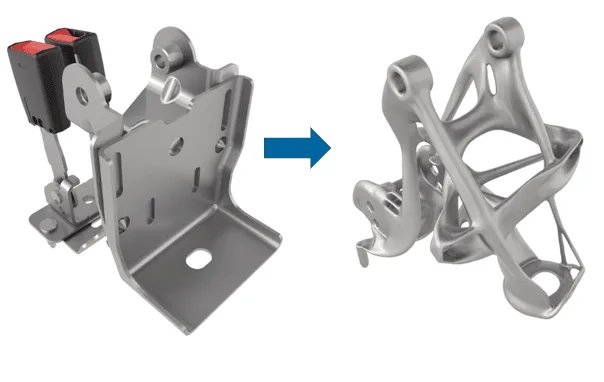The primary objective of Design for Assembly (DFA) in manufacturing is to make parts better, cost-effective, and more reliable in the least possible time.

What is Design for Assembly (DFA)?
Ideally, fewer components in a product mean less time to put all the pieces together. Design for Assembly (DFA) is a concept where the parts of a product are conveniently few to save time and costs. The design also improves the overall quality and reliability, and durability of the final product.
The fewer parts in Design for Assembly also reduce the chances of errors during manufacturing. Such fail-proofness improves product quality with highly functional results at a lower cost. Moreover, custom machined parts with simplified designs are more competitive in the consumer market to satisfy individual needs.
Objectives of Design for Assembly
DFA is highly significant because the manufacturing process is the greatest determinant of a product’s final cost. Quality problems can occur if the assembly steps are too many or too complicated. The whole process can go wrong if not carefully strategized and tested.
The essence of the DFA process is to define specific requirements for each product, including visual aspects, reliability, quality, and costs. Initial planning from the beginning ensures the assembly requirements are specific to each product and the DFA criteria is fulfilled.
That said, the significance of DFA also cuts across sustainability as manufacturers don’t only design for assembly, but also for disassembly, reuse, and maintenance, all of which have to be simultaneously considered.
Principles of Design for Assembly in Manufacturing
The objectives of DFA cut across the manufacturing industry, including computer numerical control machining (CNC). For example, it emphasizes removing complexities from parts without compromising final product quality. Cost-effective parts also describe the objective of cost reduction as the prime objective of DFA.
Ideally, the cost is primarily affected by the time taken to run the machines. That also includes the time the machine is in operation and the time to program and set up for tasks. If the time is to be reduced significantly, several DFA guidelines for every manufacturer factor in to keep and balance various concepts in checks, such as tolerances and part complexities. Others include:
- Fewer parts to cut back on production costs and make products easier for consumers to use.
- The easy structural integrity of metal parts and components to enable easy packing and shipping around the world.
- Fewer screws and fasteners as too many of them add to the overall cost. Standard options are also preferable to save money.
So let’s dive into the pipelines of the above principles and more to establish a common ground to build better products.
Reduce Fasteners
As for fasteners, while you may not be able to get rid of fasteners like bolts and rivets completely, choose common types and sizes for your entire product instead of a one-time assembly. In essence, bolts, rivets, and screws are cheap, but the installation process takes a lot of time. Snap-fits and adhesive fasteners are recommended because they are easier to assemble without the need for special production equipment.
Modular Assemblies
Including modular designs in the manufacturing process saves production time, especially when producing multiple similar products.
Realistic Tolerances
While modern production equipment makes it possible to manufacture precise parts and components, extreme tolerances are not always necessary. Ideally, some machines require a lot of time, which increases the overall production cost. Also, extremely tight tolerances mean high requirements for assembly, which would affect manufacturing assembly and make the whole process costly.
Assembly Considerations
The size of parts and components really matters when it comes to design assembly. Ideally, they should not be too large or too small to make inserting, grasping, moving, and orientation difficult.
Components with self-aligning features are easier and faster to assemble and make a big difference. The aspect of symmetry features at this point to reduce orientation time. The faster components fit around each other, the less time one spends trying to insert them into each other. While at it, avoid components like springs which jam and tangle together, as separating them wastes significant time and money.
Commercially Standardized Components
Custom manufacturing and fabrication require a lot of time as they have unique specifications tailored to the needs of individual products. It is easier, more affordable, and less time-consuming to integrate commercial off-the-shelf (COTS) parts into product designs, i.e., enclosures, gears, springs, and motors. It minimizes assembly costs and enables manufacturers to design products faster with fewer parts to put together.
Design for Assembly (DFA) Benefits in Manufacturing
DFA is a corporate requirement in many companies and more are continually adopting it in an attempt to effectively control their manufacturing costs. In essence, Design for Assembly:
- Eliminates complicated operations to speed up the production process.
- Increases the chance of creating reliable and top-notch quality products.
- Reduces repeated operations during production, thus reducing wastage of raw materials.
- Reduces the disassembly process to save, repair, and maintain costs related to heavy equipment capital for production. It also cuts back on design changes and revisions to achieve parts and components with specific designs. In turn, it reduces delays and increases the speed of manufacturing multiple products.
- Makes production more profitable and reduces labor.
- Promotes automation for various production lines like metal fabrication, which makes manufacturing easy and fast.
- Reduces the probability of errors and common failures by reducing the number of parts and components. In turn, assembled parts become more reliable.
- Ensures cost-effective production of fewer, stronger, and more durable products.
Conclusion
From the above insight, Design for Assembly had several profitable benefits for a manufacturing company. Its integration into production lines makes it very important from the initial stages of planning and strategizing to the actualization of various products. While DFA rules to live by giving you resourceful knowledge about various approaches, it is crucial to enlist a manufacturer who understands the value. That way, you’ll avoid confusion and get the most out of it.



